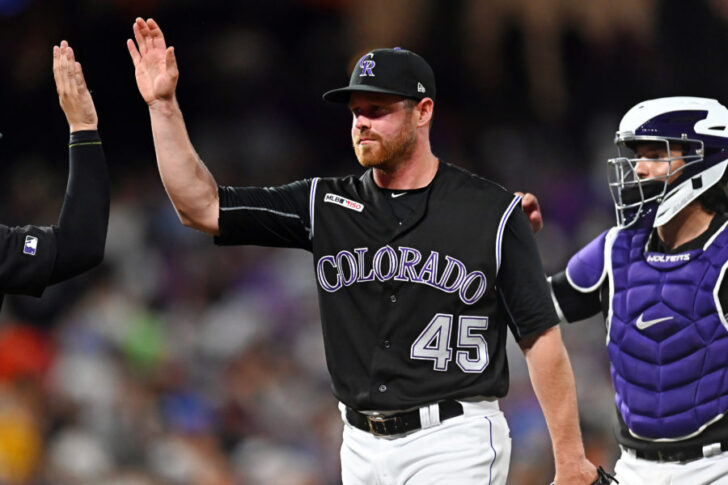Baseball is a math equation that often fails to make sense.
A 6-4-3 double play – a play that involves the shortstop fielding a groundball and tossing the ball to the second baseman, then onto first base – equals two outs. In what world can the sum of those three figures be two? Another example is 24 plus 3. The sum is 27 – also the number of outs required each team has to register to finalize a nine-inning game.
In actuality, the first 24 outs aren’t the same as the final three. For both relievers and starters across baseball, the easiest way to sum up the phenomenon is “different.”
“At that point of the game, it’s been a three-hour game, everyone has worked hard to get the lead and now you’re in a situation where it’s all counting on you to make sure you get the win,” Davis said. “All we (have to) do is get three outs.”
The pageantry that goes into the final frame for pitchers heightens the expectations. With adrenaline flowing, they are forced to overcome the desperation of another club and impose their will – all factors that add variables and make it more than simple addition.
Behind the task is a mindset that is everpresent in the league’s best closers: amnesia.
Whether the results were good, bad or middling, relief pitchers – especially closers – are forced to forget. If the blown chance needs investigating, the video is analyzed and just as soon forgotten.
“Our job is to go out and perform, throw strikes and execute,” Oberg said. “If it doesn’t happen, okay, we’ll figure out what went wrong and move on from it. That’s really all that we can do.”
While players forget, fans rarely do.
A closer can jog to the mound six times and lock down the final inning of each of them. If that seventh chance goes awry, it’s all they recall.
“Just because of the nature of the game, sometimes hitters go 0-for-4 (or) 0-for-5 and it goes unnoticed,” Oberg said. “But if a reliever gives up a whole bunch of runs, people are like, ‘yeah, I remember that guy. He gave up a bunch of runs.’”
It’s an unfair game, but one that is required anyway. The math of it once again fails to add up. Even if you subtract the bad from the good, the aforementioned week’s worth of appearances would still be a net positive.
Lee Smith, formerly of the Chicago Cubs – among seven other clubs – was one of the league’s best closers. After his 18-year career, the burly right-hander had racked up the second-most saves in league history (478).
In that same span, he racked up the third-most blown saves (103) behind only Rollie Fingers (109) and Colorado’s own, Goose Gossage (112).
Last season, similarly, Davis was able to finalize a whopping 43 saves – the highest mark in the National League. Amongst the successes was a mere six failures. All of it, in less than a full year, has been forgotten anyway.
“Nobody cares (about success),” Davis said. “That’s the hard part. You only have to get three outs, it can’t be that difficult. But it is.”
Even the Rockies’ skipper, Bud Black, has said on multiple occasions that it simply takes a different type of pitcher to man the final frame.
While the save is often used to quantify how good a player is – or isn’t – at closing a game out, it fails to consider the other factors. No stat can put into context the sheer pressure of a game’s biggest moment.
Both Oberg and Davis are armed with what it takes though.
Outside of amnesia, an overlying factor is a pinpoint focus. With the crowd noise at its apex, the hitter having nothing to lose and the opposing team trying to claw their way back, a closer is forced to hone in.
“The only thing that it comes down to is trying to execute one pitch at a time,” Oberg said. “It sounds cliche and boring, but at the end of the day, it’s really a lot harder to do than (people think).
“I take one pitch and I’m going to try to get ahead and put the ball in a good place and go from there.”
Problems can arise even with a well-executed pitch.
In his latest chance to buckle down the final inning, Oberg fell prey to the bad luck that can often define a closer’s outing.
The first two hitters – Carson Kelly on a strikeout and Josh Rojas on a groundout – both went down without any issues. With two outs and only one more needed for the final sum of 27, things went awry.
After a Jake Lamb walk, the Diamondbacks set up a pitcher’s enemy. With two outs, any ball in play would set the runner in motion – the fear of getting doubled up is non-existent.
A bloop single, placed directly between Trevor Story and Raimel Tapia scored Lamb who had trucked the necessary 270 feet in spite of the weakly-hit ball. Even when Oberg had done his best to evade trouble, it found him.
“Once the ball comes out of my hand, I can’t do anything about it,” Oberg said.
Following the same trend, Archie Bradley hit Trevor Story with a fastball before allowing a walk-off homer to Nolan Arenado in the bottom of the frame.
There’s no elixir for a hanging curveball or misplaced fastball. All of the bullpens, additional side sessions and video analysis can only do so much.
If the batter slashes the ball into the seats, it has to be forgotten. When that same faulty pitch results in a strikeout, that too has to be sent away.
The math of being a closer, in a game of faulty equations, often doesn’t make sense.
For the best in the game, it’s simply a game of finding an answer that results in wins.



